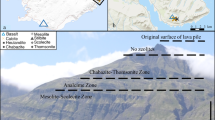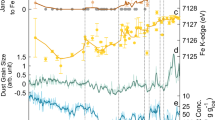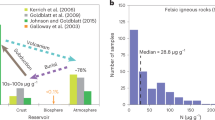Abstract
ONE of the important questions in ice-core studies is the extent to which isotope measurements made on ice loaded with bedrock debris can be trusted when interpreting the climate record from ice-core data. Here we show that the isotopic characteristics of basal ice containing debris from beneath the Greenland ice sheet can be understood only if isotope exchange between hydroxyl-bearing minerals and water is taken into account. Sub-glacial abrasion of clays and micas increases the number of broken bonds at the border of the mineral structure, promotes cleavage and so increases the rate at which these minerals exchange oxygen and hydrogen isotopes with water. One implication of our results is to call into question the recent suggestion1 that the basal ice of the Greenland ice sheet is 'superimposed ice', and that therefore extensive melting must have taken place during the last inter-glacial. The enrichment in 18O of the basal ice, thought to be acquired during the formation of the superimposed ice, may in fact be the result of isotope exchange with hydroxyl-bearing minerals.
This is a preview of subscription content, access via your institution
Access options
Subscribe to this journal
Receive 51 print issues and online access
$199.00 per year
only $3.90 per issue
Buy this article
- Purchase on Springer Link
- Instant access to full article PDF
Prices may be subject to local taxes which are calculated during checkout
Similar content being viewed by others
References
Koerner, R. M. Science 244, 964–968 (1989).
Lawson, D. E. CRREL Report 79–9, 112p (Cold Region Res. Engng Lab., Hanover, New Hampshire, 1979).
Souchez, R., Lorrain, R. & Tison, J.-L. Ann. Glaciol. 10, 163–166 (1988).
Reeh, N. & Thomsen, H. Grønl. Geolog. Undersøg. 130, 108–113 (1986).
Sugden, D. E. et al. Nature 328, 238–241 (1987).
Haldorsen, S. Boreas 10, 91–105 (1981).
Clausen, H. B. & Stauffer, B. Ann. Glaciol. 10, 23–27 (1988).
Jouzel, J. & Souchez, R. J. Glaciol. 28, 35–42 (1982).
Souchez, R. & Jouzel, J. J. Glaciol. 30, 369–372 (1984).
Savin, S. M. & Epstein, S. Geochim. cosmochim. Acta 34, 25–42 (1970).
James, A. T. & Baker, D. R. Geochim. cosmochim. Acta 40, 235–239 (1976).
O'Neil, J. R. & Kharaka, Y. K. Geochim. cosmochim. Acta 40, 241–246 (1976).
O'Neil, J. R. & Taylor, H. P. J. geophys. Res. 74, 6012–6022 (1969).
Grim, R. E. Clay Mineralogy (McGraw-Hill, New York, 1953).
Author information
Authors and Affiliations
Rights and permissions
About this article
Cite this article
Souchez, R., Lemmens, M., Lorrain, R. et al. Influence of hydroxyl-bearing minerals on the isotopic composition of ice from the basal zone of an ice sheet. Nature 345, 244–246 (1990). https://doi.org/10.1038/345244a0
Received:
Accepted:
Issue Date:
DOI: https://doi.org/10.1038/345244a0
Comments
By submitting a comment you agree to abide by our Terms and Community Guidelines. If you find something abusive or that does not comply with our terms or guidelines please flag it as inappropriate.



